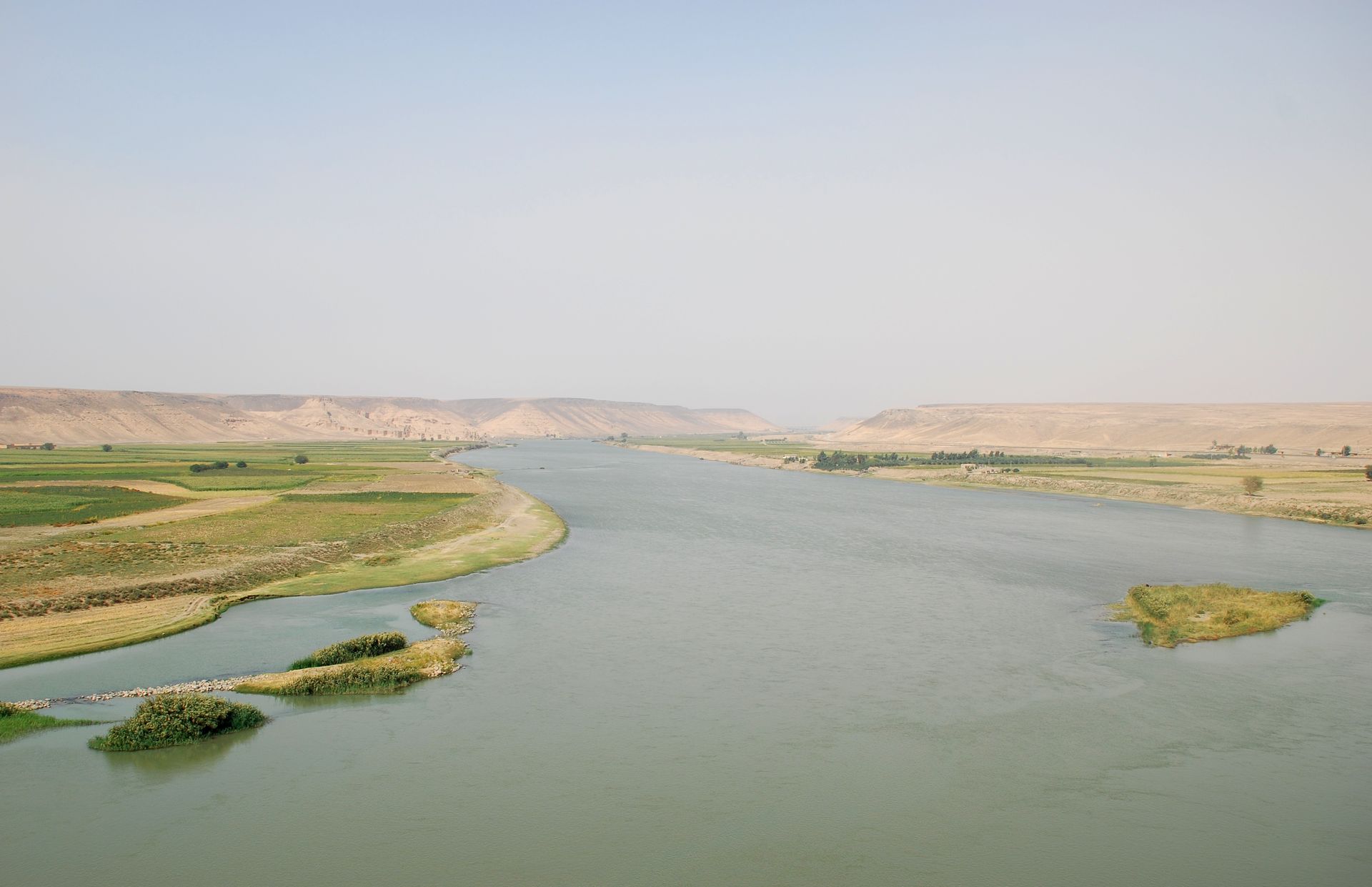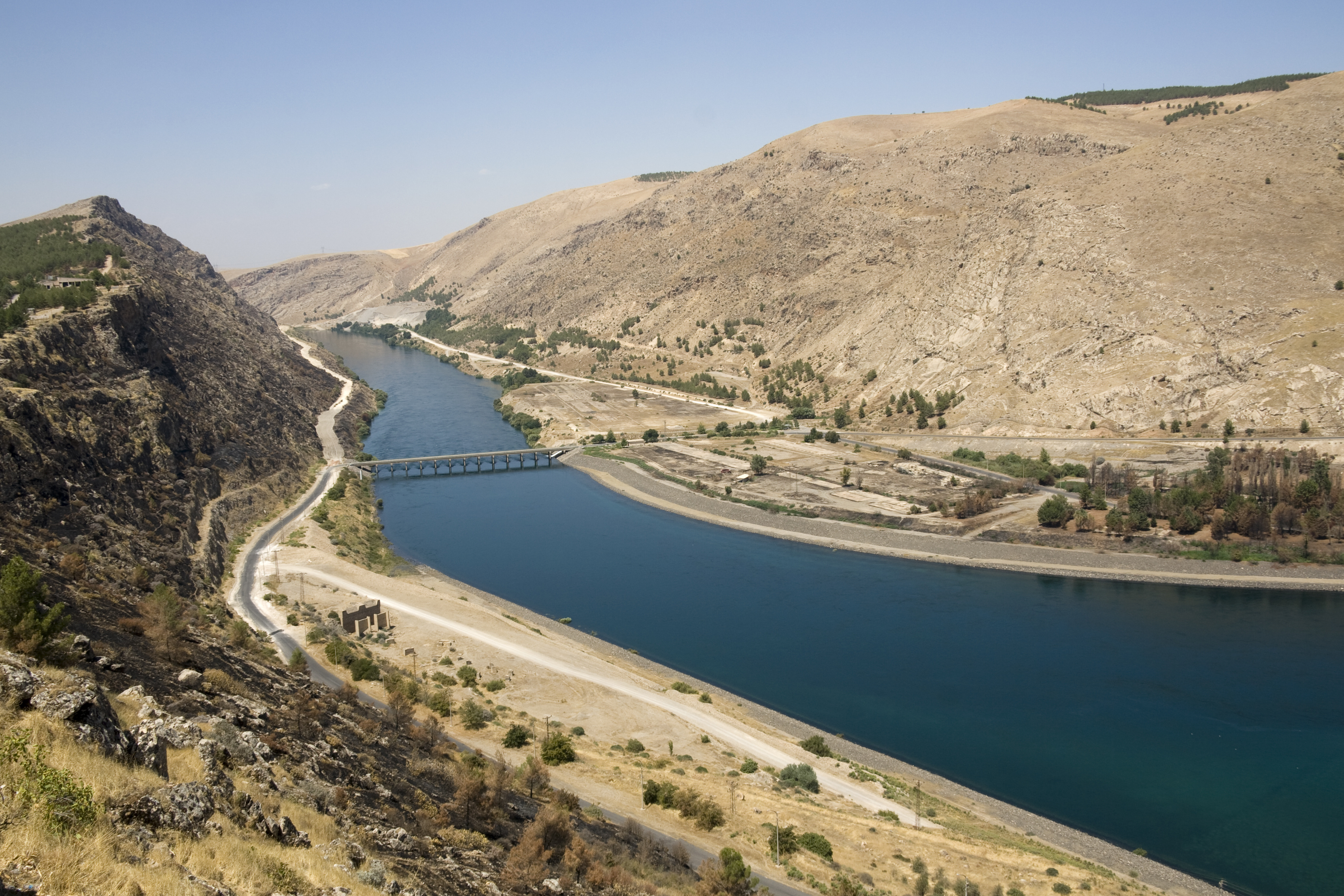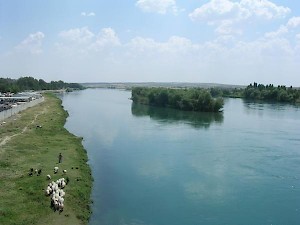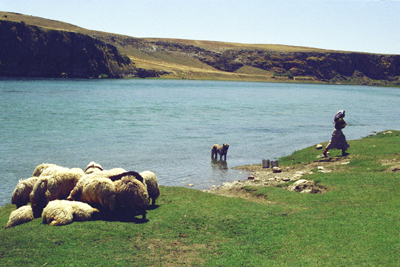Euphrates
Course of the Euphrates
The Euphrates in Ar - Raqqa, Syria
The Euphrates ( [ ɔʏ̯frat ], Greek Εὐφράτης, Euphrates, Arabic الفرات, DMG al - Furat, Kurdish Firat, Turkish Fırat ) is the largest power of Western Asia.
Course
The Euphrates has a length of 2736 km. With its longest river source, the Murat, he has a length of 3380 km. The other source is the Karasu River ( Black Water ). The two source rivers run roughly parallel to the west, both source rivers originate in Turkey in the interior of the Taurus Mountains. They combine at the Keban Dam (675 km ², 31 km ³ ) to the Euphrates. Thereafter, the current flows through the Karakaya Dam (268 km ² 9.58 km ³), the Atatürk Dam ( 817 km ²; 48.7 km ³ ) and the Euphrates barrage Birecik ( 1.2 km ³). The headwaters of the river it marks the historic border between Asia Minor and Mesopotamia. Then it flows through Syria, the dammed by the Tabqa - Assad dam reservoir and Iraq with the Haditha Dam (500 km ², 6.4 km ³) in a southeasterly direction. There he joins the Tigris to the Shatt al-Arab, which flows into the Persian Gulf.
The water level of the Euphrates is in September at the lowest and rises until May to its highest level. When the snow melts, spring floods can occur at the headwaters in Turkey. The Euphrates has already played in the days of Mesopotamian civilizations an important role for the water supply of the country. At the same time he formed in ancient times an important transport connection. Sections with rapids as the river Tight al - Khanuqa in central Syria, the more difficult an advancement, therefore of strategic importance. Here fortifications were erected.
The river, which is navigable by rafts on many of his major and minor tributaries, can be driven on for a distance of 720 kilometers with small boats. Although the water level is increased by locks, the water depth can drop to only 60 centimeters during the dry season between December and March. Where the Euphrates crosses barren and dry desert steppe in large sections, it is used as a flux for the irrigated oasis among others with cotton and grain. To this end, as channels are derived. For the production of energy and for irrigation of fields since the 1970s, several dams were built. Since the construction of several dams in the upper section of the river and the consequent ability to control the water flow of the Euphrates on the part of Turkey there have been repeated clashes between Turkey, Syria and Iraq. After the establishment of about 630 square kilometers Assad Lake in Syria, the problem of water supply for Iraq intensified further. In 1985, the Thartharkanal connecting the Euphrates with the Tigris, completed. The steadily increasing over the past decades has led water extraction according to the United Nations to lasting changes in the valley of the Euphrates. According to official data, about 90 percent of the region damaged by human activities. The marshlands of Mesopotamia is now almost completely dried up. Together with his twin Tigris River forms the Euphrates, whose catchment area covers 765,831 km ², Mesopotamia.
At the middle and lower Euphrates are the mound formerly the main cities of Emar, Tuttul, Terqa and Mari in Syria; Uruk, Ur and Babylon in Iraq. Modern cities are on the middle reaches in Syria Ar - Raqqa and Deir ez -Zor; Haditha, Karbala and Najaf are in Iraq. In the south of Iraq, the Marsh Arabs live.
Stories and narratives
According to Genesis, the paradise between the rivers Pishon, Gihon, Chidekel and Perat should be located. The Perat is often equated with the Euphrates.
After Mesopotamian myth arise Euphrates and Tigris the eyes of the primordial goddess Tiamat, who had killed Marduk and formed from her heaven and earth.
The Greeks considered the Euphrates Tigris as his brother, the son of Pontos and Thalassa.
The name Euphrates
The word Euphrates is the Greek version of the Old Persian word Ufrat. In Hebrew and Aramaic it means Prath / Froth, in Armenian: Եփրատ Yeṗrat, in Arabic Al- Furat الفرات, in Kurdish Firat or Ferat and old - Assyrian Pu- rat -tu. The Sumerian ruler Gudea called the river Buranun.
The Old Persian Version Ufrat, from most other names were derived, is derived from the compound term Huperethuua what is "good to cross " means. The word Hu is " good" and Peretu " ford ".
In the Revised Standard Version of the Bible the current Eufrat is called. In the description of the Garden of Eden is the name Perat.










